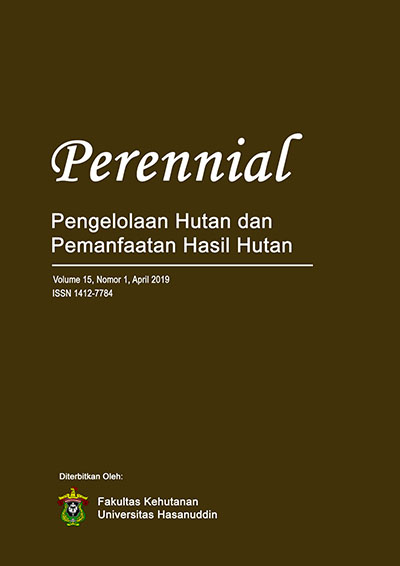IDENTIFIKASI TIPE KERUSAKAN POHON MENGGUNAKAN METODE FOREST HEALTH MONITORING (FHM)
DOI:
https://doi.org/10.24259/perennial.v15i1.6033Keywords:
fhm, tree damage, Tahura WARAbstract
Trees are an important part of the compilation of forest ecosystems blocks of collections of plants and/or animals, Wan Abdul Rachman Forest Park, Lampung Province. Block collection of plants and or animals serves as a place for collecting, protecting and preserving biodiversity. The problems that occur in this block are changes in forest areas, initially primary forests become mixed forests due to land clearing. Land clearing causes various types of tree damage which causes a decrease in tree health and forest health, so it is necessary to identify tree damage conditions. The purpose of the study was to determine the condition of tree damage based on the location of tree damage, type of tree damage and severity. Identification is carried out using the Forest Health Monitoring (FHM) method, the measurement parameter is the condition of tree damage. The study was conducted in June 2018 in a collection block of plants and / or animals Tahura WAR Kelurahan Sumber Agung, Kemiling, Bandar Lampung covering 141.18 ha. The sampling intensity used was 2.30%, data collection was carried out in eight FHM cluster clusters. Based on the results of the study there were 144 individual trees that were damaged. The location of damage occurs mostly in the roots and the lower part of the stem is 29%, the lower stem is 18% and the branches are 15%. There were 11 types of damage observed with the largest type of damage, namely open wounds by 46%, broken or dead branches by 17%, cancer by 9% and leaves, shoots or shoots damaged by 9%. The most severe severity is found in the severity of 20% with a percentage of 39%, severity of 30% with a percentage of 35% and severity of 40% with a percentage of 7%.References
Haris R, Clark J, Matheny N. 2004. Arboriculture : integrated management of landscape trees, shrubs, and vines. New jersey: Prentice Hall.
Khoiri S. 2004. Studi Tingkat Kerusakan Pohon di Hutan Kota Serengseng Jakarta Barat [Skripsi]. Bogor: Departemen Konservasi Sumberdaya Hutan dan Ekowisata, Fakultas Kehutanan IPB.
Mangold, R. 1997. Forest Health Monitoring: Field Methods Guide.Buku. USDA Forest Service. New York. 246 p.
Ngatiman. 2010. Serangan Hama Rayap Pada Tanaman Meranti Merah (Shorea leprosula MIQ.) Di Samboja. Jurnal Infoteknis Dipterokarpa. 4(1): 63—68.
Pracaya. 2008. Hama dan Penyakit Tanaman. Jakarta(ID):Penebar Swadaya.
Putra, E. I. 2004. Pengembangan Metode Penilaian Kesehatan Hutan Alam Produksi. Tesis. Tidak dipublikasikan. Program Pasca Sarjana. Institut Pertanian Bogor. Bogor.
Rahayu, S. 1999. Penyakit Tanaman Hutan di Indonesia: Gejala, Penyebab, dan Teknik Pengendaliannya. Penerbit Kanisius. Yogyakarta.
Rikto, 2010. Tipe Kerusakan Pohon Hutan Kota (Studi Kasus : Hutan Kota Bentuk Jalur Hijau,Kota Bogor - Jawa Barat). Skripsi. Departemen Konservasi Sumberdaya Hutan dan Ekowisata. Institut Pertanian Bogor. Bogor.
Safe’i, R. Harjanto. Supriyanto. L. Sundawati. 2014. Value of vitality status in monoculture and agroforestry planting systems of the community forests. International Journal of Sciences: Basic and Applied Research (IJSBAR) 18, 2, 340—353.
Safe’i, R.,Hardjanto. Supriyanto. L. Sundawati. 2015. Pengembangan metode penilaian kesehatan hutan rakyat sengon. Jurnal Penelitian Hutan Tanaman. 12, 3, 175—178.
Safe’i, R dan Tsani, M. K. 2016. Kesehatan Hutan: Penilaian Kesehatan Hutan Menggunakan Teknik Forest Health Monitoring. Buku. Plantaxia. Yogyakarta. 102 p.
Safe’i, R. Wulandari, C. dan Kaskoyo, H. 2019. Penilaian kesehatan hutan pada berbagai tipe hutan di provinsi lampung. Jurnal Sylva Lestari. 7(1):95—109.
Sumardi dan Widyastuti, M. S. 2002. Dasar-Dasar Perlindungan Hutan. Buku. Gadjah Mada University Press. Yogyakarta.
UPTD Tahura WAR. 2017. Blok Pengelolaan Taman Hutan Raya Wan Abdul Rachman Provinsi Lampung. Bandar Lampung. 58 p.
Yunasfi. 2002. Faktor-Faktor yang Mempengaruhi Perkembangan Penyakit dan Penyakit yang Disebabkan oleh Jamur. Fakultas Pertanian. Universitas Sumatera Utara. Medan.


